Battle of Kursk
Contributor: C. Peter Chen
ww2dbaseAfter a two year stalemate, both the Soviets and Germans awaited major confrontations that would define the momentum for either side. This decisive battle would occur near the town of Kursk, a town on the Moscow-Rostov railway, in Southern Russia.
ww2dbaseIn Mar 1943, German general Erich von Manstein captured Kharkov, a city south of Kursk, and formed a long perimeter along the eastern side of the city. He allowed an opening through his line, allowing Soviet forces to advance, forming a bulge, before sending in his Panzers in two pincer movements to encircle the bulge. The German forces in this battle fielded some new weapons, including the Ferdinand self-propelled artillery and the tank Pather that was designed specifically to counter the Soviet T-34 tanks. The offensive to eliminate the surrounded Soviet forces were devised by Colonel General Kurt Zeitzler, at the insistence Adolf Hitler even though Heinz Guderian opposed risking so much for what he believed to be a small gain. By the time the Germans were finally ready to launch the actual offensive, Soviet spy network "the Lucy Ring" and the British intelligence both had already learned of the attack plans, and even without the spy network the massive tank build up would had alarmed the Soviet field commanders there. Marshall Georgi Zhukov was in command of the Soviet defensive forces, who convinced Josef Stalin to hold off on a summer offensive until he could defeat the impending German attack at Kursk first. To prepare for the defense, Zhukov summoned 300,000 civilians and built a series of defenses including tank traps, mine fields, and various defensive positions. Militarily, Zhukov wielded a strength consisted of 1,300,000 men, 3,600 tanks, 20,000 pieces of artillery, and 2,400 aircraft. On the other side, the Germans were about to attack with over 800,000 men (including three Waffen SS divisions), 2,700 tanks, and 1,800 aircraft.
ww2dbaseThe battle started on 4 Jul 1943 as a series of delays, including the desperate situation in Jun 1943 that took away attention from this offensive. Nevertheless, after sappers of the Großdeutschland Division bravely and efficiently cleared a path through the mine fields the previous night, German Stuka fighters led the attack targeting the lightly armored tops of Soviet tanks, followed by an artillery barrage then by the infantry and armor. The 2nd SS Panzer Corps, 3rd Panzer Corps, and the 11th Panzer Division stormed Soviet positions, making advances through the rest of the day, but the Soviets resisted fiercely and slowed the German advances. Main reasons for the slow German advance were often attributed to the defensive structures, especially mine fields, that the Soviets painstakingly set up. Also, Walther Model of the German Ninth Army was employing a rather conservative tactic with his tanks, withholding some in reserve instead of following the usual German tactic that poured all armor strength into battle immediately. Around midnight Zhukov, armed with good intelligence on German movement, ordered a bombardment by artillery pieces, mortars, and Katyusha rocket launchers accurately on German forces.
ww2dbaseOn the next day, Paul Hausser's 2nd SS Panzer Corp advanced under a newly devised tactic Panzerkiel, where Tiger tanks opened the way for other tanks, prying through enemy defensive lines. By the second day of the Kursk offensive, German troops had penetrated 20 miles into Soviet territory, at a high cost on both sides. At Prokhorovka Hausser's flanks were supposed to be protected by the 3rd Panzer Corps, which was unexpectedly stalled by the 7th Guards Army. To take advantage of the situation, the entire 5th Guards Tank Army was deployed to strike at the 2nd SS Panzer Corps on 12 Jul, which was to become the largest tank battle in history. Armor on both sides engaged in close-range combat, while air forces took their shots at the tanks on the ground amidst the fierce dogfights in the air. Armor-piercing anti-tank guns also made their share of damage during the battle. As tanks on both sides burned and sent thick smoke into the sky, aircraft could no longer tell friend from foe, and slowly disengaged themselves from ground targets in fear of striking friendly units. At the end of the day when the battle subsided, the Germans had lost 60 tanks and Soviets 822.
ww2dbaseAs casualties mounted high for both sides, Hitler made a surprising announcement to withdraw part of the German forces to reinforce Italy, a response to the successful western Allies' landing in Sicily. After the German strength weakened after the withdrawl, Soviet forces continued on to liberate Oryol, Belgorod, and Kharkov after the Battle of Kursk.
ww2dbaseAlthough the Soviet forces suffered heavier casualties at Kursk than the Germans, the engagement was a success for the Soviets in that they stopped a planned German offensive. Historians attributed a tactical victory to the Soviets at Kursk for that the German forces were depleted and demoralized at the end of the battle without support of reserve forces. Manstein made the recommendation to Hitler that a final reinforcement at Kursk could have turned the tides of the battle and destroyed the Soviet troops present in the area mending their recently received wounds, but Hitler had already made up his mind to shift his focus to Italy. At the end of the fighting in Kursk, the German forces had suffered 200,000 casualties and lost 500 tanks, while Soviet losses amounted to 860,000 casualties and 1,500 tanks. Although the Soviet losses in tanks were greater than that of the Germans, at this time the Kirov tank factory along with other factories on the east side of the Ural mountains were just reaching their peak production capability while the German factories were becoming stressed. In fact, German armor would never regain its numerical superiority over their Soviet counterparts again.
ww2dbaseSources: the Fall of Berlin, Wikipedia.
Last Major Update: Jan 2006
Photographs
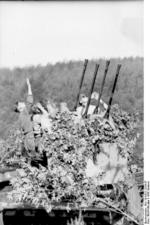 | 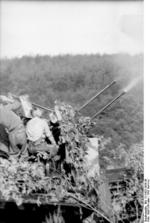 | 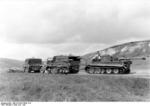 | 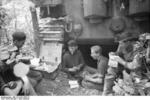 |
Maps
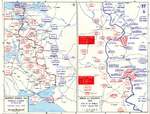 | 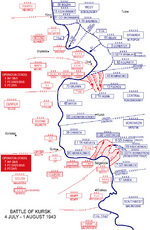 |
Battle of Kursk Timeline
| 11 Apr 1943 | Adolf Hitler issued orders that the best armies, the best leaders and the best weapons were to be made available for employment in the "Encirclement of the enemy forces deployed in the Kursk area". |
| 4 May 1943 | Hitler postponed Operation Citadel, which ultimately would give the Soviets more time to prepare their defenses. |
| 10 May 1943 | Heinz Guderian told Adolf Hitler of his misgivings about the Zitadelle plan. Uncharacteristically Hitler responded that, he too, had concerns about an offensive at Kursk, Russia. |
| 1 Jul 1943 | Hitler addressed the generals slated to command Operation Citadel. |
| 3 Jul 1943 | Germans launched Operation Citadel, aimed at encircling and destroying Soviet forces in the Orel-Belgorod salient in Russia. Soviet air activity had delayed the launch by one day. |
| 4 Jul 1943 | The Battle of Kursk, what would become the largest tank battle in history, began. |
| 6 Jul 1943 | In Russia, in the north of the Kursk salient, on Central Front, Konstantin Rokossovsky launched a counter-attack, throwing in three tank corps. But it foundered on former Soviet minefields which the Germans had reinforced, and the Soviets instead took up fixed positions to act as a breakwater against a renewed German assault. |
| 7 Jul 1943 | Soviet Il-2M aircraft, attacking in huge numbers, destroyed some seventy tanks of the German 9th Panzer Division in just twenty minutes during the Battle of Kursk. German aircraft also saw much action, with He 111 tactical bombers alone flew 178 sorties. |
| 8 Jul 1943 | In the Kursk salient Walter Model's armour made three thrusts into the centre of the Soviet defences along the Central Front, the villages of Teploye, Olkhovatka and Ponyri in Russia. At Teploye, the main objective was Hill 272. Time and again the Germans assaulted it, after attacks by swarms of Stuka dive bombers which dropped 550-pound bombs on the anti-tank positions. But the Soviets were well dug in and camouflaged. They preferred to fight the Germans at close range, where their anti-tank rifles and dug in T-34 tanks took a devastating toll. The Germans took the hill three times, but the Soviets continued to recapture it. |
| 11 Jul 1943 | German forces in Operation Citadel ran out of momentum, even though there had been some objectives reached. Hitler refused to call off the operation, which could have saved many of the units. |
| 12 Jul 1943 | Soviet forces launched a massive offensive along their Bryansk, Central, and West Fronts in Russia, toward Bryansk, Kursk, and Orel. Prokhorovka, Russia became the site of what would be hailed as the largest armor battle in history. |
| 13 Jul 1943 | Hitler called off the Kursk offensive but the decision had already been taken from him by the Soviets who pounded the retreating German forces both north and south of the salient with tanks, artillery, and tank-busting aircraft. Apart from the Soviet Army, the victory at Kursk was as much a triumph for the Soviet workforce which has endured long shifts in appalling conditions to arm, clothe, and feed their fighting men. |
| 14 Jul 1943 | The Soviet Voronezh Front joined in the offensive against German 4.Panzer Armee and Armeeabteilung Kempf south of Kursk, Russia. |
| 19 Jul 1943 | Soviet troops began to threaten German positions at Bolkhov, Russia. |
| 20 Jul 1943 | German troops evacuated Mtensk, Russia. |
Please consider supporting us on Patreon. Even $1 per month will go a long way! Thank you. Please help us spread the word: Stay updated with WW2DB: |
Visitor Submitted Comments
15 Jan 2006 02:52:19 PM
A good range of information. This site is meant to brief people on the event, while there are other websites dedicated to an event Kursk for instance.
19 Jan 2006 02:37:02 AM
you are quoted as the german lost only 50 tanks and the russian 822...are you sure about that figure?
19 Jan 2006 06:00:41 AM
At Prokhorovka the German losses were only about 50 (some claim slightly higher number, but none over ~80), not the entire course of the Kursk actions. The final tally is listed further below in the article, estimating the final losses to be about 500 tanks for the Germans and 1500 for the Russians. Please review the article once more for details, thanks!
11 Jan 2010 06:53:48 AM
I was able to rent this DVD this past week.
It provides GREAT detail of the equipment of both the Russians and Germans, their troops and their commanders at Kursk.
If you can get a copy to watch it is WELL worth it. It clearly provides the battle plans and movements of both sides during the battle.
I highly recommend this DVD and it is actual film footage from the actual event.
War File: Battlefield: The Battle of Kursk (2008)
23 Apr 2011 03:38:12 PM
"Historians attributed a tactical victory to the Russians...". This is an understatement at best.
Other historians think that Kursk was THE decisive battle of WW2. Even if you just look at the (real) numbers of German losses, the significance of this battle was more than that of Italian campaign or Normandy landing (the D day). Then consider not only the numbers but the quality of German troops. France was defended by meager leftovers of the once mighty Wehrmacht.
More importantly, the Red Army came close the pre-war USSR border on a 3000 km-wide front, after which Romania, on the far south of that front became indefensible from the Bolsheviks. This, in turn, meant inevitable collapse of German armed forces and industry as Romania provided the bulk of German oil.
Kursk was strategic victory for Stalin. As the result of that battle, USSR was firmly established as a world superpower. England and France lost their influence in Europe for the following 50 years and possibly forever.
2 Jul 2011 08:09:13 PM
This account is nonsense. Hitler was on the verge of winning this battle when he pulled many of his troops and armour out to send to Italy and the Balkans to defend against allied advance. This account is based on corrupt Soviet propaganda. I know the real truth, because I've read the German account.
12 Jul 2011 06:22:54 PM
Anonymous, I salute you. You have brought truth to this communist propaganda site.
25 Jul 2011 11:57:33 PM
Germans won the Kursk battle but They must withdraw because Nort and South of Kursk front Russians prepared to start new offensive and circle germans again like in Stalingrad. Obviously Hitler didn't want second Stalingrad!
13 Sep 2011 05:18:21 AM
The Kursk operation was betrayed by a treasonous German officers clique in service to the Soviet Union. That clique sabotaged most of Germany's main battles on the Eastern Fron front 1941-45. They caused the slaughter of millions of German troops. What we know as WW2 history is mostly Soviet-serving lies.
Most US people who comment om history are ignoramuses repeating Soviet bias originated in WW2.
28 Sep 2011 09:21:33 PM
Typical soviet rubbish about the battle. The german was a much better fighter than his soviet counter-part in w.w.2. Fighting vast @ superior odds @ a never ending supply of tanks @ men.This is why the german soldier performed skilfully @ superior for so long!
26 Mar 2012 12:03:22 PM
If the Pro-Germanic critics are so neagatively critcal of the article, perhaps they could provide another interpretation based upon the historical facts. I would like to see a wider history about this turning point in history. One fact is clear is that Hitler was unable to mount another major offensive on the Eastern Front after his withdrawl at Kursk.
28 Jun 2012 02:00:37 PM
i would say its a general description of the battle based on some sourses.It doesnt means its nonsenses it doesnt means its the abslolute historical facts.
p.s. the casualties seems inaccurate
26 May 2014 06:09:42 PM
I know this argument or debate is old but, I will put my say into it. There may have been double agents in the German army, I'm not sure about that, this to me sounds like an excuse for the failure and misjudgment of an unfit leader. The only double agents that I know of were the Cambridge five, which were British spies that gave information of German troop movements to the Soviets. Also the casualties of Kursk here look to be an average of various reports, because no one actually knows how many men and vehicles were lost. Though it is generally agreed that the Soviets lost five times more troops than the Germans. This is also considered by most scholars whether they be German, American, Russian, or any other nationality you can think of, as the turning point of the war in Europe. At this point Germany was not producing enought material or vehicles to build up after any major losses. While at the same time any losses by the Soviets could be easily replaced, due to an impressive production rate and the vast population of the Soviet Union. While I'll admit Germany may have been able to push the Soviets back and gain more land if they tried, it was not the best option. Advancing would have spread their already overworked armies even thinner, effectively making any defense of territory impossible. So, retreating and switching to defensive warfare was the best option Germany had. Kursk may have gone differently if Hitler attacked in May like his staff advised, but he decided to wait for more tanks to be produced, which made no difference because this allowed the Soviets time to make their lines nearly impenetrable. If the attack was staged in May the German panzers would have smashed through the Soviet defenses at the time, this would force the Soviets back into a defensive war. Which would have prolonged the war in the east and may have led to a total German victory over the Soviet Union. At the least it would have raised German morale, and would probably have led to an increase in German recruitment. Of course this is not what happened.
30 May 2014 12:18:19 PM
@14
Full *** comment!
24 Jun 2014 02:22:01 PM
I have to say, website owner-editor, that you sure are patient with some of the tin-foil that posts in the comments section. Between neo-Nazis and post-fall communists, the wild extremes of both sides run rampant. :-)
Just read the article, you jugheads. It's based upon reliable, authoritative historians who've actually looked at the primary data. Deal with it.
20 Apr 2016 12:55:21 AM
In fact, the Soviet spies in the German Army were very important for that battle. The famous Lucy Ring gave so many informations to the the Soviet Union that almost any part of the plan was known. For example, you can read Operation Scratched Earth, by Paul Carell.
Tactically, Kursk was a German victory. From a military point of view, a victory is a battle in which your infantry gains positions, and the German Army only gained positions in the first part of the battle. A victory can be too expansive, like the famous victory of King Pyrrhus Ⅱ's Army. At Koursk, 56000 were killed, or 6.2 % of the 900000 German soldiers (or 800000 according to this article), and 142000 of the 1300000 Soviet soldiers (10.9 %), so either in absolute and in relative number Kursk was a German victory.
However, Germany was fighting with forces far greater than its own ones, and a the only way for Hitler to win the war before being totally outnumbered – as it was to happen in 1944 – was to destroy the whole Soviet Army at Kursk, and to pierce the Soviet forces.
The Anglo-Saxon landing in Sicily, and General Patton's quick conquest of this island forced Hitler to send in Italy several divisions : it was the end of the German offensive at Kursk.
2 Feb 2019 09:01:43 PM
17. FF is completely ignorant to characterize U.S> Sicily invasion as "Anglo Saxon". English are not Germanic and they should cease calling themselves Saxons or any other Germanic reference
21 May 2020 07:56:30 AM
Actually, the English are Germanic. Germanic ancestry is the most common and the English language is mostly Germanic.
10 Jun 2020 09:28:22 PM
I don't know where RU Rosenberg went to school or where he gets his information but Central European including Germanic influences like Saxons were part of the Angles ( English ) makeup. My family traces back nearly a thousand years in Northern and Central England with references to Saxons, Vikings and French. I think your obvious prejudice is showing.
26 May 2021 07:46:39 PM
There is no doubt that the English are Germanic.
20 Jan 2022 02:03:12 AM
god this comment section was a clown car. From Neo Nazis to People arguing over someone saying 'anglo saxon' im english and idgaf that someone refers to us as that. OH NO, we were fighting the Nazis in ww2, we cant have german refernce/heritage/relations
All visitor submitted comments are opinions of those making the submissions and do not reflect views of WW2DB.
» Bagramyan, Ivan
» Greim, Robert
» Hausser, Paul
» Hoth, Hermann
» Kamanin, Nikolai
» Khudyakov, Sergei
» Konev, Ivan
» Manstein, Erich
» Model, Walter
» Novikov, Alexander
» Rokossovsky, Konstantin
» Rotmistrov, Pavel
» Vasilevsky, Aleksandr
» Vatutin, Nikolai
» Zeitzler, Kurt
» Zhukov, Georgy
Location:
» Russia
Notable Aircraft:
» Il-2 Shturmovik
Related Books:
» Atlas of the Eastern Front 1941-45
» He 111 Kampfgeschwader on the Russian Front
» Kursk 1943: The Northern Front
» When Titans Clashed
- » 1,169 biographies
- » 337 events
- » 44,828 timeline entries
- » 1,244 ships
- » 350 aircraft models
- » 207 vehicle models
- » 376 weapon models
- » 123 historical documents
- » 261 facilities
- » 470 book reviews
- » 28,520 photos
- » 365 maps
Captain Henry P. Jim Crowe, Guadalcanal, 13 Jan 1943
Please consider supporting us on Patreon. Even $1 a month will go a long way. Thank you!
Or, please support us by purchasing some WW2DB merchandise at TeeSpring, Thank you!
25 Apr 2005 07:17:16 AM
not enough info. on Kursk